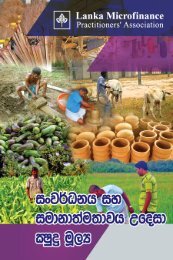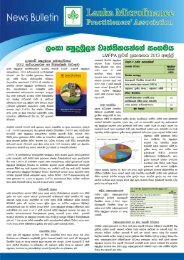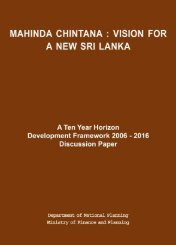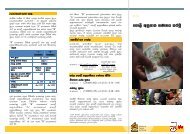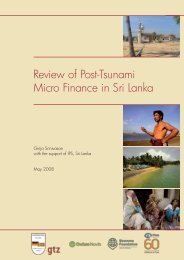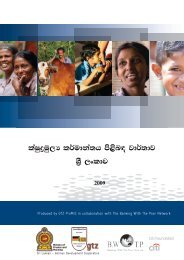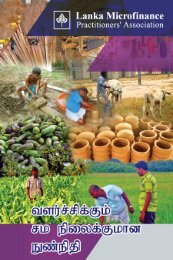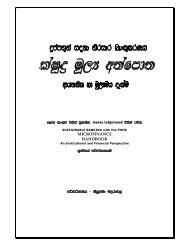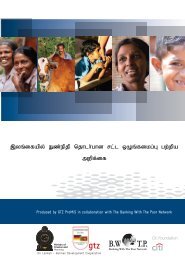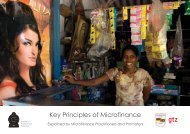National Microfinance Study of Sri Lanka: Survey of Practices and ...
National Microfinance Study of Sri Lanka: Survey of Practices and ...
National Microfinance Study of Sri Lanka: Survey of Practices and ...
You also want an ePaper? Increase the reach of your titles
YUMPU automatically turns print PDFs into web optimized ePapers that Google loves.
As a result the banks are moving away from micr<strong>of</strong>inance as part <strong>of</strong> their overall<br />
product range towards developing specific ‘in-house’ operational units or<br />
specialist divisions. However they are presently still obliged to deliver some<br />
limited ‘general’ micr<strong>of</strong>inance products mainly due to ongoing government rural<br />
credit programs that contain micr<strong>of</strong>inance components.<br />
3. <strong>Micr<strong>of</strong>inance</strong> in the North <strong>and</strong> East Region <strong>of</strong> <strong>Sri</strong> <strong>Lanka</strong><br />
Part C <strong>of</strong> the report summarises the intervention environment for micro finance in<br />
the North & East. The survey found that alongside traditional savings <strong>and</strong> credit<br />
activities, micr<strong>of</strong>inance project implementation in areas affected by conflict has<br />
three main features <strong>of</strong> differentiation, namely:<br />
<strong>Micr<strong>of</strong>inance</strong> can be implemented in cases even where the local infrastructure<br />
has been devastated.<br />
<strong>Micr<strong>of</strong>inance</strong> is a flexible tool that has the ability to assist relief interventions<br />
to meet a community's basic needs <strong>and</strong> is used by a range <strong>of</strong> actors for<br />
different reasons across the relief spectrum.<br />
<strong>Micr<strong>of</strong>inance</strong> is an effective economic recovery tool that helps to regenerate<br />
local economies <strong>and</strong> form a bridge into economic development.<br />
The survey reviews the 'enabling environment' for micr<strong>of</strong>inance interventions in<br />
the region in terms <strong>of</strong> people, economic livelihoods, markets, infrastructure,<br />
governance, security <strong>and</strong> dem<strong>and</strong> issues. The survey found that broadly there was<br />
a positive environment for micr<strong>of</strong>inance intervention throughout the region but<br />
that the region itself is highly localised <strong>and</strong> any intervention strategies need to be<br />
planned based on knowledge <strong>and</strong> research <strong>of</strong> local conditions.<br />
The survey found that the infrastructure, utilities, services <strong>and</strong> immobile capital<br />
assets <strong>of</strong> this region have over the past eighteen years been eroded by conflict<br />
resulting in the region’s economic decline. A large number <strong>of</strong> communities have<br />
been displaced <strong>and</strong> formal employment even in the primary industries has<br />
fundamentally declined.<br />
The region has been excluded from the major micr<strong>of</strong>inance interventions<br />
managed through <strong>and</strong> by the central government for the past decade <strong>and</strong> a half<br />
<strong>and</strong> although the state <strong>and</strong> private commercial banks in the region operate current<br />
<strong>and</strong> savings accounts, access to credit is limited.<br />
There has been some continued access to micr<strong>of</strong>inance through the TCCS,<br />
however due to the conflict <strong>and</strong> displacement many branches <strong>and</strong> some <strong>of</strong> the<br />
district unions have become defunct. The Cooperative Rural Banks that continue<br />
to operate in the region are taking deposits, but the majority are only considering<br />
disbursing loans with grant in aid funding from the international community.<br />
Most access to micr<strong>of</strong>inance for the communities in the region is through<br />
interventions by international donors, agencies <strong>and</strong> organisations either directly or<br />
implemented through regional <strong>and</strong> local non-governmental organisations. This<br />
has resulted in a proliferation <strong>of</strong> NGOs utilizing micr<strong>of</strong>inance for a broad range <strong>of</strong><br />
services including, health, education, social services, village infrastructure as well<br />
as consumption smoothing <strong>and</strong> income generation activities.<br />
25




